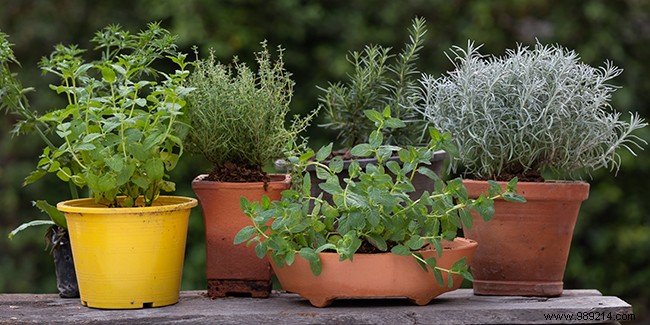
Whether you have a garden, a terrace, a simple balcony or just a window sill, nothing prevents you from creating a small herb garden to enhance your cooked dishes, your salads or your desserts. Even if you are not an expert or passionate about gardening, nothing could be easier than creating a "simple" garden!
Aromatic plants, for the most part, manage to grow in pots or planters, however to avoid territorial conflicts or bad associations, it is better to install them each in an individual pot.
Depending on your available space, choose pots of a good size so that the roots do not feel cramped too quickly. Avoid small planters that hang from the balcony, their depth is generally insufficient.
Choose terracotta pots, which are weatherproof, inexpensive for basic models and fit well into any environment. Their porosity sometimes causes the soil to dry out more quickly. Glazed earthenware pots offer the opportunity to vary the colors, they are often magnificent.
The wood of the planters gives a rustic side but can be very heavy once the container is filled with potting soil. You can hijack wine crates, apple crates or create your own custom made from reclaimed pallet wood.
Metal pots can be very decorative, but beware of the sun, which can make them hot, dry out the soil and damage the roots. Some metals can also be very heavy and/or rust unsightly.
Stone tubs and pots are not very suitable for aromatic crops and their weight can weigh down your balcony at the limit of the maximum authorized load.
Plastic pots are light but at a time when plastic is not yet recycled and a 7th continent is made up of it, is it really reasonable to add more? Prefer recycling by hunting for old pots or containers that you will divert for your plantations.
In the bottom of the pots, place a good layer of draining materials such as clay balls, shards of flowerpots, gravel, etc. and cover it with a geotextile felt so that the earth does not come to amalgamate with the pieces which would then lose their draining function.
Prepare a mixture of potting soil, topsoil and well-rotted compost in equal parts. Stir so that it is homogeneous and fill the pot, leaving room to insert a young plant in a bucket or small container.
Mulch with a not too coarse mulch, such as hemp straw, dry shredded material or small pebbles.
Place each pot on a saucer to collect the drainage water, especially if you are on a balcony.
Maintain well:regular watering and pruning are essential to ensure the longevity of aromatic potted plants.
On a balcony, conditions can be tough:severe cold, dreadful heat waves, drought, storms, etc. which invites you to choose well-adapted plants.
For example, for a southern exposure, thyme, wild thyme, mint, lavender, sage, lemon verbena, basil, chives, coriander, parsley will flourish well, while in the north, it is better to opt for tarragon, sorrel, lovage , as well as chives, cilantro, parsley.
The Living Earth Cheat Sheets * sur les Aromatiques will give you all the advice on cultivation, harvesting and use adapted to each aromatic plant, in a small block that fits in your pocket:very clever.
And even a very small herb garden on a balcony can turn into a small biodiversity reserve:butterflies and other pollinators will be interested in the nectar and pollen of flowers!
* Living Earth Editions - 56 pages - 8.5 x 16 cm - February 21, 2021 - €8